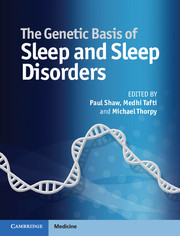Book contents
- The Genetic Basis of Sleep and Sleep Disorders
- The Genetic Basis of Sleep and Sleep Disorders
- Copyright page
- Contents
- Foreword
- Preface
- Contributors
- Abbreviations
- Section 1 Generalprinciples of genetics and genomics
- Section 2 Geneticsof sleep and circadian rhythms
- Section 3 Sleepphysiology and homeostasis
- Chapter 14 Genetics of sleep and EEG
- Chapter 15 Genetic interaction between circadian and homeostatic regulation of sleep
- Chapter 16 Genetic approaches to understanding circadian entrainment
- Chapter 17 Animal models for cognitive deficits induced by sleep deprivation
- Chapter 18 Individual differences in sleep duration and responses to sleep loss
- Chapter 19 Clock polymorphisms associated with human diurnal preference
- Chapter 20 Sleep and long-term memory storage
- Chapter 21 Sleep and synaptic homeostasis
- Section 4 Insomnias
- Section 5 Narcolepsyand hypersomnias
- Section 6 Sleep-related breathing disorders
- Section 7 Circadian rhythm sleep disorders
- Section 8 Parasomniasand sleep-related movement disorders
- Section 9 Psychiatricand medical disorders
- Section 10 Medication effects
- Index
Chapter 19 - Clock polymorphisms associated with human diurnal preference
from Section 3 - Sleepphysiology and homeostasis
Published online by Cambridge University Press: 05 November 2013
- The Genetic Basis of Sleep and Sleep Disorders
- The Genetic Basis of Sleep and Sleep Disorders
- Copyright page
- Contents
- Foreword
- Preface
- Contributors
- Abbreviations
- Section 1 Generalprinciples of genetics and genomics
- Section 2 Geneticsof sleep and circadian rhythms
- Section 3 Sleepphysiology and homeostasis
- Chapter 14 Genetics of sleep and EEG
- Chapter 15 Genetic interaction between circadian and homeostatic regulation of sleep
- Chapter 16 Genetic approaches to understanding circadian entrainment
- Chapter 17 Animal models for cognitive deficits induced by sleep deprivation
- Chapter 18 Individual differences in sleep duration and responses to sleep loss
- Chapter 19 Clock polymorphisms associated with human diurnal preference
- Chapter 20 Sleep and long-term memory storage
- Chapter 21 Sleep and synaptic homeostasis
- Section 4 Insomnias
- Section 5 Narcolepsyand hypersomnias
- Section 6 Sleep-related breathing disorders
- Section 7 Circadian rhythm sleep disorders
- Section 8 Parasomniasand sleep-related movement disorders
- Section 9 Psychiatricand medical disorders
- Section 10 Medication effects
- Index
Summary
- Type
- Chapter
- Information
- The Genetic Basis of Sleep and Sleep Disorders , pp. 197 - 207Publisher: Cambridge University PressPrint publication year: 2013
- 3
- Cited by



